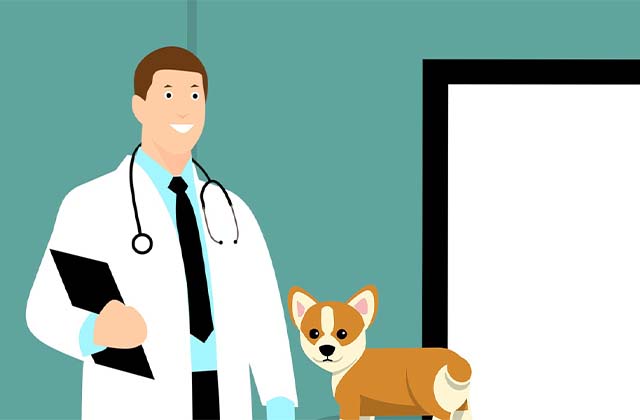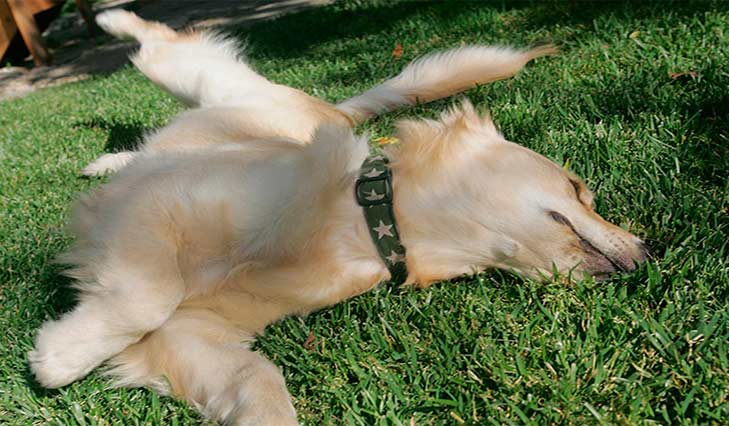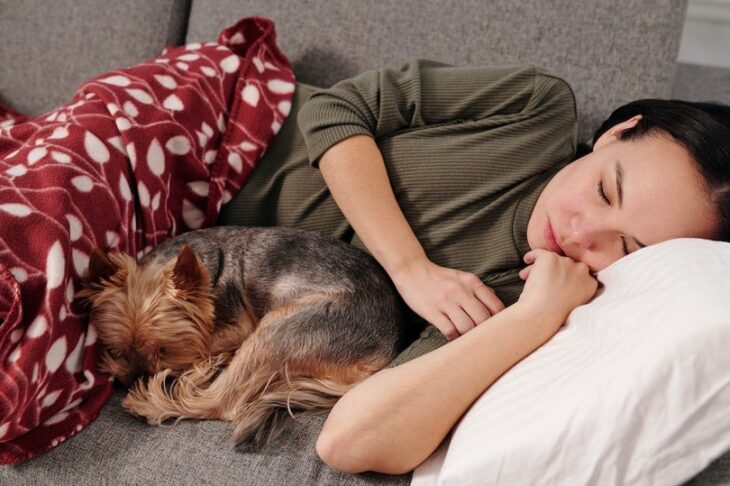
My Dog Doesn’t Like Sitting At Desk: Why?
Have you ever had a situation when my dog doesn’t like sitting at desk? They might have a history of escaping when you try to place them in their chair, or they might just have trouble staying put for more than a few minutes.
Don’t worry if you’re having trouble with this; there are solutions available. This post will offer some advice on how to easily train your dog to sit at your desk.
Dogs naturally wander, making it challenging to confine them for an extended period of time. There are, however, a few things you can do to make your dog feel more at ease while they are working at a desk.
Table of Contents
Why My Dog Doesn’t Like Sitting At The Desk?
Get Injured
Given the possibility of an injury, dogs might not suddenly decide to sit on a desk or anything else. When they are hurt or get injured, dogs won’t communicate that to you. To be a good pet owner, you must observe your animals and determine whether they are healthy or not.
While playing outside or with another dog, dogs can suffer injuries for a variety of reasons. Aside from that, they risk hurting themselves by running into something and getting hurt.
Pay attention when your dog doesn’t sit on the desk or anything else because whatever caused your dog’s injury could have fatal consequences.
Joint Problems
Hip dysplasia and joint problems can occur in certain dog breeds. Osteoarthritis is a common name for these joint conditions. Your dog may experience problems as a result of these conditions and won’t be able to sit on any felt surface, especially a desk.
If you look behind you, you can quickly determine whether or not your dog is limping as a result of a joint problem.
If your dog has a knee or leg condition, standing, walking, and sitting may be challenging for them. Take your dog to the veterinarian right away if you notice any joint problems and make sure he receives the necessary care.
Dogs may suffer from joint problems if they are injured or if they lie in a particular position. If these problems are not addressed, a limb could be amputated.
Read about: How Fast Can A Pitbull Run?
Anal Gland Problem
Another common issue that can cause your dog to limp is the anal gland. Dogs who have conditions like swollen or inflamed anal glands are more likely to have trouble sitting. You might discover the reason your dog won’t sit if they aren’t perched on your desk.
If you look closely, you can see a red, irritated anal region, which is another sign of an anal gland issue. There may be an unpleasant odor coming from an injured anal region.
It can make sitting uncomfortable and make defecating difficult. Your dog can’t sit on the desk or the floor because of this because it’s extremely uncomfortable and itchy.
Due To Accident
If your dog was injured in an accident or a fight, he might have trouble sitting at the desk or on the floor. When they venture outside to play and engage in combat with other dogs, dogs frequently get into fights.
Dogs can also sustain injuries from insect bites or bee stings. Your dog may have strained a muscle, suffered a cut, or developed an uncomfortable bruise.
Whatever the cause, if your dog won’t sit on the floor or a desk, you should look for all the symptoms. If you are unable to identify your dog’s problem, take your pet to the veterinarian. Your veterinarian can assist you in ruling out more serious scenarios like tumor growth.
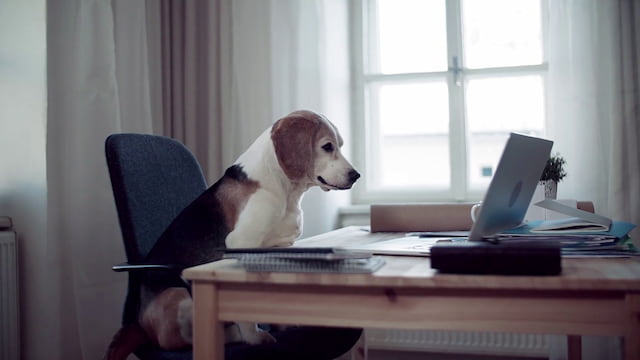
They Like To Sniff Things
Dogs enjoy sniffing things out. Your dog might not feel comfortable spending the entire day at a desk if they are accustomed to being on the hunt constantly. You can try to give your dog a place to sniff (such as a dog crate) or a task to complete (such as cleaning the office).
They Are Social Animals
Many dogs enjoy being around people. It might not be comfortable for your dog to spend the entire day at a desk if it isn’t used to being by itself. You can try to involve them in office activities or try to find them a canine companion to stay with them.
They Like To Play
Dogs enjoy playing, so if they are accustomed to playing constantly, they might not feel comfortable working at a desk all day. You can attempt to give them some play areas (such as a dog crate) or try to find them a canine companion to accompany them while they are away from home. If your dog is unwilling to sit at a desk, you might want to think about getting them a cozy dog bed instead.
They Want Something
Consider your pet’s behavior changes before drawing the worst conclusions, such as that your dog may be hurt or have a joint issue. Your dogs frequently ignore your commands and do whatever they want when they are agitated or angry.
Your dog might attempt to act strangely to let you know if you don’t give them enough time. Give your pet the appropriate amount of time so that they won’t display aggressive behaviors.
Feel Uncomfortable
Many people believe that a desk is an excellent place for a dog to sit because it’s cozy. However, many dogs dislike sitting in chairs because they find them uncomfortable. Since desks are frequently low to the ground, a dog might feel uneasy there. Consider buying your dog a comfy dog bed instead if they are unwilling to sit in a chair.
Get Bored
For a dog, working all day at a desk can be very boring. Your dog might start to get bored and restless if they’re not used to staying still. By offering your dog toys, treats, and games, you can try to make the workspace more engaging for them.
Too Quiet
Overly silent environments can make some dogs uneasy. Many people believe that a desk is a great place for a dog to sit since it’s a busy environment. However, because offices tend to be too quiet, many dogs dislike sitting there. You might try turning on some music or watching TV to create some background noise.
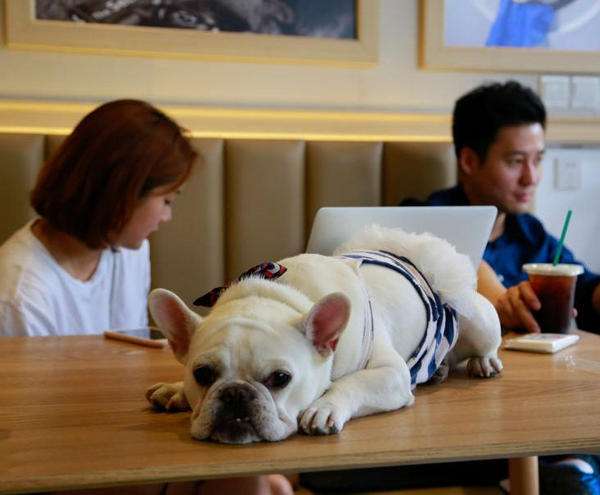
Why Does My Dog Sit Under My Desk?
A few typical explanations for why dogs do it are listed below, along with information that would make them more likely to be the primary cause.
It Is More Comfortable
Dogs frequently lie down or sleep under desks. Yours may have been doing it because it is simply more comfortable there. This is more probable if your dog otherwise acts normally and doesn’t exhibit any signs of fear or anxiety when in the house.
It Feels Safer
It may act in this manner because it perceives a sense of safety there. It can protect itself from above by lying or sitting under the desk, which increases the likelihood that it will be able to see potential threats. It would probably feel safer being close to you. Even though there is no reason for your dog to be afraid, this could be the reason why it behaves in this way. If it has a personality that is more submissive, this is more likely to be the cause.
Your Dog Wants Something From You
It might be acting in this way because it is hoping to receive something from you, like a walk or food. This would be more likely if it did it more frequently when you normally fed or walked the animal. The food that you have on your desk may also be the cause if that is what it is attempting to do.
Something Has Been Causing It To Be Fearful
It’s possible that something has been making it fearful, leading it to hide under the desk where it feels safer. This would be more likely if it has a tendency to do it more frequently at a particular time, such as when there are loud noises outside or when a specific person is nearby.
How To Train My Dog To Sit An The Desk?
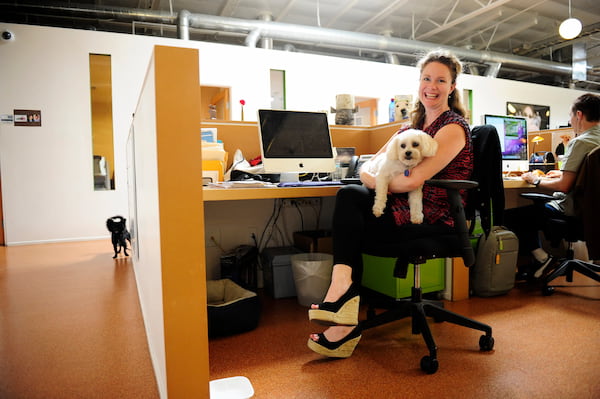
Every Time, Obey
You may have a difficult dog or you may not have been consistently enforcing the command if you had previously trained your dog to sit but he simply won’t listen to you now or only occasionally does. Dogs vary in their levels of stubbornness and eagerness to please. Nevertheless, whichever breed your dog is, if he can avoid obeying you when he wants to do anything else, he will.
Train When It Is Appropriate
In fact, an energetic dog will typically find it difficult to focus and will most likely not want to be sitting down. He would much rather be chasing a ball around. When your dog isn’t a huge bundle of explosive energy, you will always be able to get more attention from him and have greater control over him. Anything to burn off some energy, such as walking your dog, playing tug of war, or kicking a ball around the yard. Reduce your dog’s energy level to a manageable level. However, keep in mind that puppies frequently sleep a lot as well. Therefore, keep training sessions brief, coming after some playtime but before he falls asleep.
Improve Your Training Rewards
Like other dogs, yours will typically do everything to get food. It is highly doubtful that your dog won’t be eager to use all means necessary to get you to give him a good enough treat. So, this one is simple. How does he respond when you hold the treat in your hand and approach him? Does he give it a short sniff before acting primarily bored or uninterested? Give him a treat for nothing and see if he returns begging for more or wanders off. Purchase some nicer goodies if your dog doesn’t seem to care all that much about them. If you want some moist training goodies, try some freshly grilled chicken.
When You’re Not Properly Instructing Him
This could indicate that you aren’t properly assisting your dog in understanding what you want from him or that you’ve inadvertently been rewarding him with treats when you meant for him to sit. (Buying a “clicker” is useful for dog training. This is done to click and mark the precise instant your dog sits, after which you immediately reward him with a treat. Due to the fact that you can click far more quickly than you can offer a treat, he eventually gets acclimated to the click as a signal for positive behavior.
Use The Correct “Seduction” Action
You can’t explain to your dog what you want it to do. So the only real way is to lure it to do it with rewards. Click here to view the complete guide that teaches your dog how to sit. If you have a snack in your hand and the dog is standing in front of you, what will the dog do if you move the snack onto the dog’s head according to the guide’s advice? It may jump up or reach for food. If so, your hands and food are raised too high. You should clench your fist and put it back (from your dog’s point of view) right on its nose. Sometimes you need to make very slight adjustments to your opponent’s placement and movements. Try to make some changes and observe how your dog moves and reacts. You can put his hand in front of his face, a little lower, and then move in his direction, and at the same time move up to his nose. If your dog starts to turn around because your hand is moving on his head, stop and move the food forward again. You may need to stop letting his hands touch his nose. You may need to move the waiter slowly. Try these methods to see what works.
How To Keep Your Dog From Sitting on You?
Most of the time, you enjoy having your dog jump up and sit on your lap. However, it can be uncomfortable for you when your dog tries to spend the entire day on your lap. When your dog tries to sit on you, get up to discourage them from doing so.
While you could kindly push them away, your dog might interpret this as a bad action and decide not to come back to you. Once they realize that you don’t like it when they constantly sit on you, keep standing up.
Why Did Dogs Like To Sit For Most Of Their Time?

Although dogs also develop the habit of sitting on the floor, tables, or other cozy objects, cats are typically thought of as being more cuddlers. Dogs primarily engage in such behavior because they enjoy relaxing in a familiar location and observing their surroundings.
Less roving than cats, they enjoy sitting in the sun during the winter and in front of an air conditioner during the summer.
Not just large and giant puppies are affected by this situation; all breeds of dogs are as well. Even smaller dogs enjoy sitting whenever they have the opportunity. If your dog enjoys taking a seat during the majority of the day, you must allow them to do so. Out of all the resting places, they frequently prefer to sit on you while you work.
Why Is My Dog Always Under My Feet?
Canine Instincts
Dogs are herd animals. Even if your spoiled dog has never been outside in the wild, they still exhibit these behaviors.
The habit of sitting on your feet is frequently just a vestige of their ancestors’ DNA.
Dogs roam the wild in packs. In order to stay safe and cooperate in order to survive, they act in this way.
They congregate when they are sleeping or taking a break. The pack’s leader is given the coziest spot, and the other dogs curl up next to him to stay warm.
You are in charge of the pack in your house.
Young dogs are also exposed to some aspects of pack mentality very early on. Canine puppies are taught to snooze close to their mothers’ tails. In the event that the mother rolls over while she is sleeping, this will prevent being crushed.
If you have a young puppy, they might still act in this way since it’s all they’ve ever known.
Safety
In the eyes of your dog, you have many roles as the pack leader of your household. The protector is one of the most important roles you’ll have to play.
Your dog will seek your protection if they are a little uneasy about something.
With more submissive dogs, this occurs frequently. Even the largest and most intimidating breed, though, will go to their owner if they feel unsafe.
New people, loud noises, and other unfamiliar stimuli can cause dogs to become anxious. To feel more at ease, they’ll sit or lie down at your feet.
Sometimes all it takes to reassure your dog is a touch from you.
Take note of your dog’s sleeping patterns if they doze off on your feet. They feel completely safe if they are lying on their side and have your feet warmly tucked underneath.
In the wild, it is very dangerous for them to be in this position because it exposes their belly. They’re telling you they trust you to keep them safe by lying on their side.
Protection
On the other hand, your dog might sit on your feet to shield you from a perceived danger. They’ll put themselves in your path between the threat and you in order to keep you safe from any harm.
There is typically no real threat at hand. However, that won’t stop your dog from offering you the defense they believe you require.
Territorial Claims
Has your dog ever sat at your feet or been in close proximity to you in a dog park? They probably do this to demarcate their territory.
In essence, the behavior communicates to other dogs that you are the pack leader and that they should respect you.
Your dog feels the same way about you even though you might think of your animal companion as one of your own.
Affection
Simply out of love for you, your dog may be resting, lounging, or sleeping at your feet. They want to touch you, hear you breathe, and smell you.
Your dog may be acting out because they miss you and don’t want you to leave again if you have been gone all day.
To reassure you, some dogs will also display affection. Dogs are perceptive animals that can easily detect your emotions. Your dog will be there to soothe you if you’re sobbing, feeling ill, or exhibiting signs of stress.
This behavior is entirely normal. In fact, if your dog is sitting at your feet just to show you that they love you, it means that you’re being a great owner.
Your dog appreciates everything you do for them, enjoys spending time with you, and doesn’t want you to leave.
How Long Does It Take To Train Dog to Sit?
A dog must typically be trained to sit within a week. The command might, however, be picked up by some dogs more quickly than others. As soon as your dog understands the command, you can start working on longer durations and introducing distractions.
Training sessions ought to be quick (5–10 minutes), regular, and enjoyable for both you and your dog.
Conclusion
No matter how hard you train them, some dogs just don’t enjoy working at a desk. Some dogs find sitting in a chair to be confining and uncomfortable, while others simply prefer to be active all the time. Pay attention to your dog’s body language and behavior, and if anything seems off, take them to the doctor to rule out anything more serious. Your dog should ultimately begin to like sitting at the desk with some time and practice.

